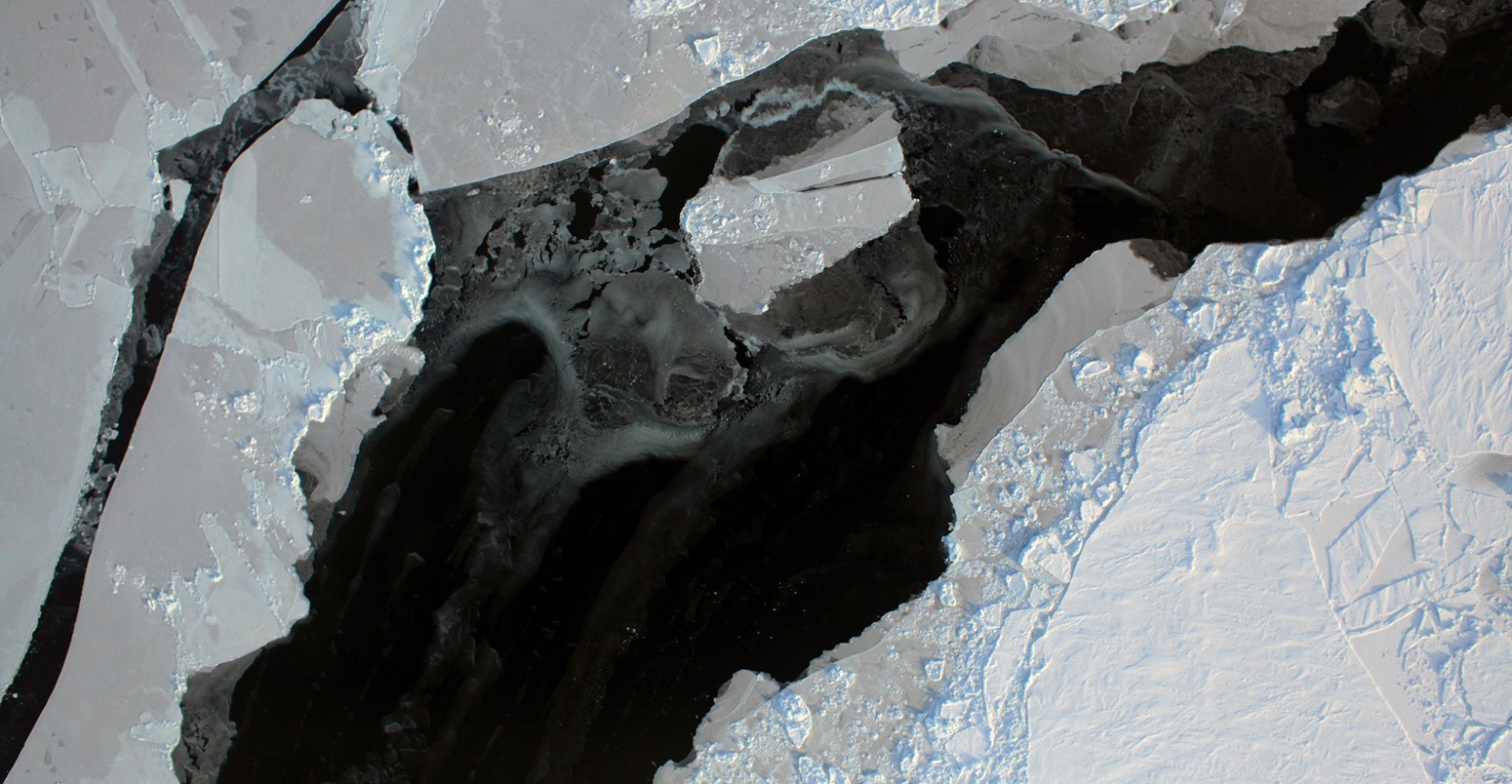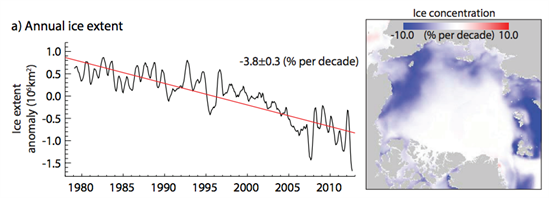
Why aren’t climate models better at predicting Arctic sea ice loss?
Roz Pidcock
12.17.14Roz Pidcock
17.12.2014 | 1:20amClimate models generally do a poor job of capturing how rising temperatures in the Arctic are affecting sea ice. Most underestimate the rapid pace at which sea ice is diminishing.
Why is that?
Scientists at the massive science conference hosted by the American Geophysical Union (AGU) taking place now in San Francisco have been discussing why it is so difficult to capture what’s happening to Arctic sea ice in climate models, and how we can make the most reliable forecasts possible with the tools available.
A policy-making tool
Arctic sea ice extent has been declining by about four per cent per decade, with the seasonal low at the end of summer shrinking particularly quickly.
Decadal trend in Arctic sea ice extent since 1979 (left) Map of changes in sea ice concentration across the Arctic (right) Source: IPCC 5th Assessment Report (Sep 2013)
Reliable forecasts of how warming will affect sea ice are important for decision making, Professor Julienne Stroeve from the US National Snow and Ice Data Centre told the AGU conference. This includes questions like when the Arctic is likely to be sea ice free in summer.
But only a quarter of models simulate a rate of sea ice loss comparable with that observed by satellites since 1979, according to the Intergovernmental Panel on Climate Change (IPCC).
So where are they going wrong?
Shortcomings
One major limitation of most climate models is that they don’t give a complete picture of the physics that governs interactions between sea ice, the ocean and the atmosphere, Professor Danny Feltham from the University of Reading explained in the session.
Some physical processes that affect sea ice take place on smaller scales than models can simulate. Scientists instead have to simplify the effect those processes have on sea ice using mathematical equations to represent the complex physics. This is known as parameterisation, Feltham told us:
“When I say it’s important to improve the physics in climate models, I mean that it’s important to include parameterisations of processes that aren’t currently in climate models or to make those that are included already more realistic.”
Melt ponds are a good example, Feltham explains. These pools of meltwater on the surface of the sea ice affect how much of the sun’s energy is reflected by sea ice, and how much is absorbed. Ridges that develop when ice floes collide make the surface rougher and can also affect the interactions between the ocean, sea ice and atmosphere.
Why is it so hard to get these physical processes right?
One reason is that the processes are new areas of research and nobody has studied them in detail yet, says Feltham. But the real challenge is that scientists need to test models against real-world observations and at the moment, those observations are very thin on the ground.
Scientists need data about physical processes occurring across the whole Arctic, increasing the scale of the task even further, Feltham says:
“Fieldwork is crucially important, but if you’re only making observations in a few points, it’s not clear how you can scale that up the the whole Arctic”.

Scentists sampling meltponds as part of NASA’s now-completed ICESCAPE project. Credit: NASA/Kathryn Hansen
Making forecasts
When it comes to making forecasts of sea ice loss, the fact that most models don’t match up well with recent observations is an issue, says Stroeve.
The IPCC uses a subset of about five models that appear to be doing a better job than the rest. But it could be that they’re getting it right for the wrong reasons, Feltham explains:
“All models have an incomplete representation on physics and it could be that the way you’ve balanced the physical processes means the model does a reasonably good job against current observations”.
But the best models now might not necessarily be the best ones in ten years’ time, he adds:
“As the sea ice cover and climate in general is evolving, different physical processes assume more or less importance. And so unless you capture the physics behind those processes, you can’t predict how they’re going to change in future.”
Selecting a subset of models based on a comparison with a particular time period is no guarantee of a reliable forecast, says Stroeve:
“You have to ask yourself the question, if the models perform well in one time period, does that mean they will perform better in the future? From our analysis that’s not the case.”
And the time period chosen for the comparison may influence how well the models appear to be performing. Only a quarter of models resemble the trend in observations up to 2012 but if you include data for 2013 and 2014, you get a better match to reality, Stroeve points out.
A weighted approach
Stroeve has an interesting solution. Rather than using a subset of models, her approach uses all available climate models but attaches a different level of importance to each one depending on how well they match observations. Models that don’t match well don’t contribute much to the forecast, while ones that perform best contribute the most. The mix is constantly checked against each year’s data to make sure it’s the best combination, she told the AGU crowd.
Another thing to consider is that a single model might not realistically capture how natural variability changes sea ice on a year-to-year basis, Stroeve explains:
“If you’re trying to forecast when the Arctic will be sea ice free, that will depend on the natural variability in the particular model or range of models you select â?¦ Taking all the models together might be one way to sample the whole range of natural variability that you could expect”.
Applying this approach suggests that in a scenario where emissions peak around 2040 and start to decline, there will still be just over one million square kilometres of sea ice left in summer by 2080. This is the threshold considered to define a “sea ice-free” Arctic summer.
Stroeve’s team has submitted the new research for publication in Nature. The next job for the team is to look at doing the same analysis for a higher, business-as-usual emissions scenario, which could well tell a different and more dramatic story, she tells us.

